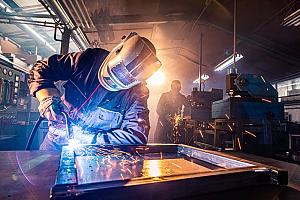Project Manager
- FMA
- The Fabricator
- FABTECH
- Canadian Metalworking
Categories
- Additive Manufacturing
- Aluminum Welding
- Arc Welding
- Assembly and Joining
- Automation and Robotics
- Bending and Forming
- Consumables
- Cutting and Weld Prep
- Electric Vehicles
- En Español
- Finishing
- Hydroforming
- Laser Cutting
- Laser Welding
- Machining
- Manufacturing Software
- Materials Handling
- Metals/Materials
- Oxyfuel Cutting
- Plasma Cutting
- Power Tools
- Punching and Other Holemaking
- Roll Forming
- Safety
- Sawing
- Shearing
- Shop Management
- Testing and Measuring
- Tube and Pipe Fabrication
- Tube and Pipe Production
- Waterjet Cutting
Industry Directory
Webcasts
Podcasts
FAB 40
Advertise
Subscribe
Account Login
Search
Is there an alternative to those wooden pallets?
Space-saving material storage options help fabricators achieve eco-friendly efficiency
- By Jordan Meyer, CPIM
- Updated July 1, 2024
- June 27, 2024
- Article
- Materials Handling

Most metal fabricating companies look at wooden pallets as a necessary evil. They get the job done, acting as a base for shipping raw materials and finished goods, but they also are difficult to deal with after shipments are completed and can cause safety concerns.
Sheet metal fabrication is a long-established process that has accompanied the development of human civilization since the 15th century, when Leonardo da Vinci first sketched his idea for a rolling mill. From automated production lines to precision-bending robotic CNC press brakes, sheet metal fabricating continues to be refined today, and demand for these services continues to increase.
Manufacturers are expanding their operations to keep up, but often within the constraints of their existing facilities. Finding ways to operate more efficiently forces them to examine their processes, many of which may not have changed for decades. And as sustainability becomes a more important focus for metal fabricators, they are looking for ways not only to streamline their operations but also to meet and display their environmentally conscious initiatives within their current factory footprint.
The Importance of Effective Material Storage
Unplanned downtime in production is one of the biggest hindrances to a company’s overall revenue and growth. Disruptions to production are inevitable, but they can be mitigated by integrating the right equipment and processes to maintain productivity on the shop floor.
Proper material packaging often is an unforeseen investment that pays dividends on the shop floor when the right materials arrive undamaged and can be easily transferred into production. It becomes a burdensome task when operators need to leave their workcell to find, unbury, and quality-check their material to keep their machines fed. While operators are spending time looking for material, the machines that require the material begin to sit idle. The more idle time for machines, the more production downtime for the shop, directly affecting profits (or losses) and lead times for the manufacturer.
Finding, retrieving, and checking that the material is not damaged are all non-value-added costs for a business. Taking a holistic view across the entire supply chain can lead to efficiencies that might never have been achievable with decades-old material storage methods.
The Finances and Impact of Dunnage
Proper material packaging often is an unforeseen investment that pays dividends on the shop floor when the right materials arrive undamaged and can be easily transferable into production. The way material is packaged and braced during transit is often referred to as dunnage. While wood pallets are historically the most common form of dunnage for sheet metal manufacturers, it is not the most efficient nor environmentally friendly way to move material.
Since 2001, steel consumption per capita has steadily increased from 150 kg to 233 kg in 2023. By 2050, steel production is expected to increase by more than 20%. With more steel being processed than ever before, many do not see the environmental impacts and additional costs that wooden pallets carry with each load.
The average life span of a sheet metal pallet is the transit time from supplier to vendor. Once the material is unloaded from the truck, the pallet becomes waste and any effort in moving it is wasted effort. Returning or recycling pallets can be a short-term solution but are still attributed with additional costs to do so. Sending pallets to a chip yard for recycling can be a sustainable disposal practice, but someone will need to continuously oversee the process. As more sheet steel is processed, the never-ending cycle of finding ways to dispose of the pallets continues.
Let’s take a deeper dive into what it takes to build a wooden pallet for sheet metal material handling. On average, a tree can produce two 10-ft. logs, which equates to roughly 63 board ft. for each log. Now, consider a typical manufacturer that receives 40,000 lbs. of 60- by 120-in. sheet material every week. If this material is shipped on eight pallets, each weighing 5,000 lbs., it amounts to a staggering 208 trees annually. While this tree count may appear modest, for manufacturers dealing with weekly shipments, the cumulative impact becomes exponential as steel processing continues.
A more holistic approach needs to be taken to see the true costs wood pallets carry with each load. Not only do wood pallets stretch the carbon footprint for manufacturers, they also accrue the costs of doing so onto their financial statement.

Customized vertical storage racks can be used as an alternative to wooden pallets. They are reusable and have a longer life span than their wooden counterparts. Also, they can be used as part of vertical storage systems, where the racks slide right into individual storage slots.
The way material is shipped and managed is far overlooked during the financial analysis for any business since it is assumed as a commodity to obtain material. Although pallets may seem like commodities, they are recognized as true assets and come with a price. The expendable costs for wooden pallets in material pricing is not only an accessorial cost, but it also accrues as more material is ordered and received.
On average, the typical sheet metal wooden pallet costs between $50 to $100 each. With sheet metal received on multiple pallets on a weekly basis, that cost becomes substantial for any manufacturer. Referencing the previous scenario, a typical manufacturer receiving eight pallets of material each week amounts to an additional cost of roughly $800 per week, or $41,600 annually, for wooden pallets alone.
Additionally, as material is received, material handlers have nowhere to store the pallets other than on top of each other. Although pallets may have a specific load rating when grounded, when placed on top of one another or in a typical cantilever-style rack, the pallet might not function according to the rating it was intended for. This is a widespread practice for sheet metal manufacturers and can create serious safety and quality concerns—either cracked pallets, or damaged sheets.
Vertically Tiered Cartridge Storage
One alternative approach to dunnage is a manual cartridge storage system that is vertically tiered. These customizable systems comprise vertical storage racks and reusable, damage-resistant re-rack cartridges, each of which fit into an individual slot. These re-rack cartridges secure sheet metal material, protecting it during transport to and from material suppliers. When removed from the storage rack, the re-rack cartridges can be stacked and engaged with each other; the load capacity is distributed evenly across the perimeter re-rack bushings without any additional weight directly on the material itself, helping to protect the sheet metal.
“We spend less time building and refurbishing skids to get them back into production, and we have seen an increase in quality,” said Don Roddy, operations manager at Ryerson Steel. “When a material is on a wooden skid, it is more susceptible to damage from the sides as well as on the top surface. With [the] cartridges, it eliminates that susceptibility completely.”
Integrating the cartridges into cut-to-length lines can help streamline material loading and shipment processes for both sheet metal suppliers and manufacturers. It helps create a milk-run process of sending and receiving sheet material, establishing a safer protocol and helping to ensure consistent delivery of high-quality materials to the fabricator.
Since this type of cartridge system decreases reliance on wooden pallets, it can help fabricators reduce their carbon footprint as well.
“Ryerson embraces the green initiative through carbon tracking, and by integrating [the] cartridges, we further limit our lumber use and reduce the concern for damaged material,” Roddy explained.
Moving away from a decades-old dunnage method can help fabricators optimize efficiencies, from material receipt to storage and machine loading. With a vertical cartridge storage system, the risk of material damage is decreased, as is the number of inbound material shipments, which in turn saves on fuel costs and contributes to an eco-friendly operation. Operators don’t need to leave their workcells, enhancing productivity and reducing production downtime. Together, this reduced environmental footprint and increased efficiency can help contribute to fabricators’ sustainable business growth.
About the Author
Related Companies
subscribe now

The Fabricator is North America's leading magazine for the metal forming and fabricating industry. The magazine delivers the news, technical articles, and case histories that enable fabricators to do their jobs more efficiently. The Fabricator has served the industry since 1970.
start your free subscription- Stay connected from anywhere

Easily access valuable industry resources now with full access to the digital edition of The Fabricator.

Easily access valuable industry resources now with full access to the digital edition of The Welder.

Easily access valuable industry resources now with full access to the digital edition of The Tube and Pipe Journal.
- Podcasting
- Podcast:
- The Fabricator Podcast
- Published:
- 06/25/2024
- Running Time:
- 64:35
Matt Brunner, co-founder and co-owner of Manitowoc, Wis.-based Brunner Fabrication joins us to talk about how he transformed...
- Industry Events
Precision Press Brake Certificate Course
- July 31 - August 1, 2024
- Elgin,
Laser Welding Certificate Course
- August 6 - 8, 2024
- Farmington Hills, IL
Golf 4 Manufacturing
- August 19 - 18, 2024
- Waukegan,
The Fabricator's Technology Summit
- August 20 - 21, 2024
- Eglin, IL
































